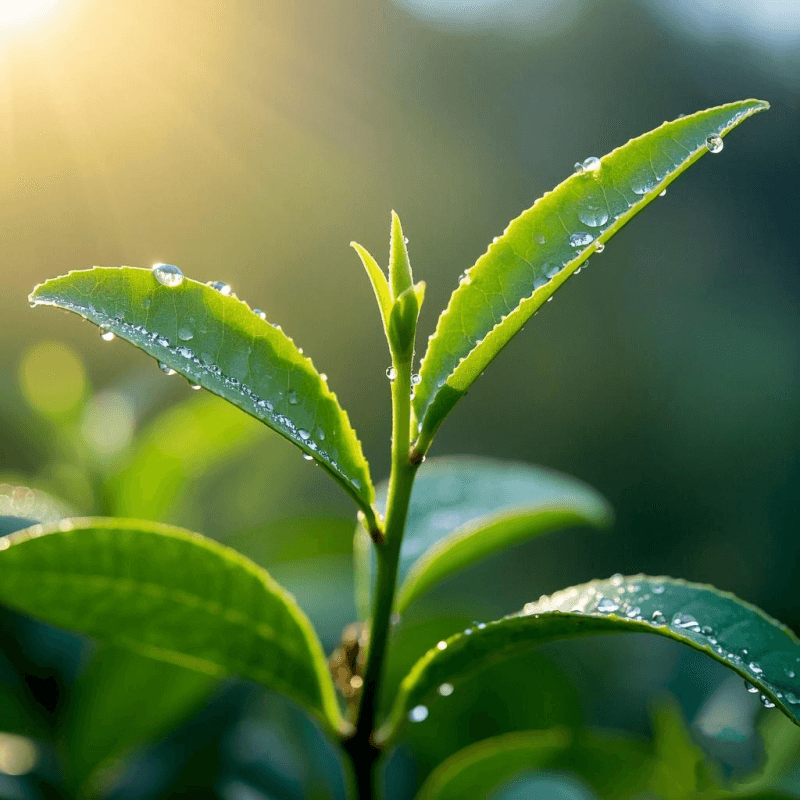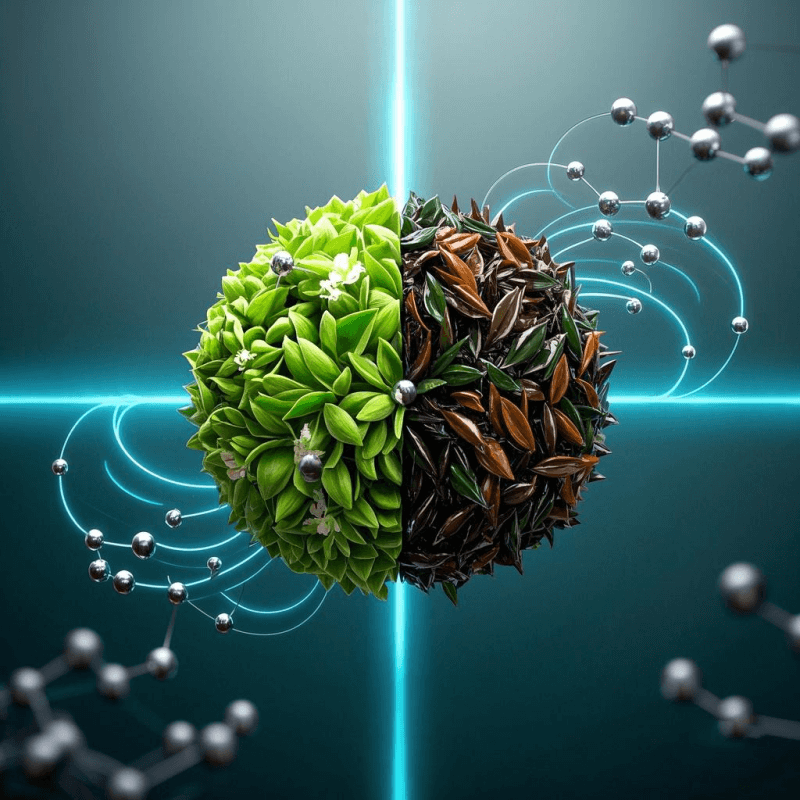
1. Introduction: Why Understanding Oolong Tea’s Composition Matters
When you sip a cup of oolong tea, you’re tasting more than just a beverage—you’re experiencing a blend of nature, science, and tradition. But have you ever stopped to wonder, what is oolong tea made of? This question isn’t just for curious minds; it’s key to understanding why oolong stands apart in flavor, aroma, and health benefits.
Many tea drinkers enjoy oolong without realizing its complex makeup. From the soil in which its leaves grow to the processing that transforms those leaves, every element shapes what’s in your cup. Whether you’re a casual sipper or a health enthusiast, knowing what is oolong tea made of helps you choose better teas, brew them properly, and appreciate their unique qualities. Let’s explore the answers step by step.
2. What Is Oolong Tea Made Of? Core Ingredients and Growing Conditions
At its most basic level, oolong tea begins with a single plant, but the story of what is oolong tea made of goes far beyond that. To truly understand, we must start with its source: the Camellia sinensis shrub, a versatile plant that adapts to its environment, creating distinct leaf profiles.
🌱 The Plant: Camellia Sinensis Varieties
Not all Camellia sinensis produces the same tea. Oolong tea is often crafted from specific cultivars selected for their ability to develop complex flavors during processing:
- Da Hong Pao: A rugged variety from China’s Wuyi Mountains, with thick, resilient leaves that hold up to extended oxidation—critical for the rich flavors oolong is known for.
- Tie Guan Yin: A delicate cultivar from Fujian Province, prized for its tender leaves that release floral aromas when lightly oxidized.
- Taiwanese Alpine Varieties: Such as Alishan and Sun Moon Lake oolong, grown in high-altitude regions where thin air and cool temperatures slow growth, creating leaves with concentrated sugars and amino acids.
Farmers harvest only the youngest parts of the plant—the top 2–3 leaves and a small bud—because these contain the highest concentration of the compounds that define what is oolong tea made of: antioxidants, amino acids, and essential oils.
🌍 Growing Conditions That Shape Its Makeup
The environment plays a starring role in answering what is oolong tea made of. Here’s how:
- Soil Composition: Oolong thrives in well-draining soil rich in minerals like iron, calcium, and potassium. Fujian’s red clay, for example, infuses leaves with earthy undertones, while Taiwan’s volcanic soil adds subtle sweetness.
- Altitude: Tea grown above 1,000 meters (3,280 feet) develops slower, with smaller leaves that pack more nutrients. This slow growth increases L-theanine (an amino acid) and catechins (antioxidants), key components in what is oolong tea made of nutritionally.
- Climate: Misty, humid conditions—common in oolong-growing regions like the Wuyi Mountains and Taiwan’s Alishan Range—protect leaves from harsh sunlight, preserving delicate flavor compounds. Annual rainfall between 1,500–2,000mm ensures consistent growth without water stress.
Discover the premium ingredients behind our finest oolong tea—sourced from these ideal regions to ensure every cup reflects the best of what oolong tea is made of.
3. Processing Secrets: How Oolong Tea Gains Its Flavor
While the plant and environment lay the foundation, processing transforms raw leaves into the oolong tea we know. This step-by-step transformation is critical to understanding what is oolong tea made of in terms of flavor and chemistry.
🔄 Key Processing Steps
- Plucking: Timing matters—leaves are harvested in spring (March–April) or autumn (September–October) when nutrient levels peak. Over-plucking or harvesting too early reduces the compounds that make oolong special.
- Withering: Fresh leaves are spread on bamboo mats in shaded areas for 4–8 hours, losing 20–30% of their moisture. This activates enzymes that start breaking down chlorophyll, the first step in creating oolong’s golden hue and mellow flavor.
- Tossing and Bruising: Leaves are gently shaken or rolled to break cell walls, releasing sap that interacts with oxygen. This starts oxidation, a chemical reaction that transforms bitter compounds into more palatable ones—a key part of what is oolong tea made of flavor-wise.
- Oxidation: The most crucial step for defining oolong’s character. Leaves rest in controlled rooms with 60–70% humidity and temperatures around 20–25°C (68–77°F). Depending on the desired style, oxidation ranges from 10–80%:
- Light oxidation (10–30%): Preserves bright, floral notes (e.g., Tie Guan Yin).
- Medium oxidation (30–60%): Balances floral and fruity flavors (e.g., Dong Ding oolong).
- High oxidation (60–80%): Creates rich, roasted profiles (e.g., Wuyi Da Hong Pao).
- Fixing: To stop oxidation, leaves are briefly pan-fried at 150–200°C (302–392°F) or steamed. This “locks in” the current flavor profile, ensuring the compounds that answer what is oolong tea made of remain stable.
- Rolling and Shaping: Leaves are twisted into curls, balls, or strips. This step isn’t just cosmetic—tight rolling concentrates flavors, so when brewed, the leaves unfurl, releasing layers of taste.
- Drying and Roasting: Final drying removes remaining moisture (to 3–5%), preventing mold. Some oolongs undergo charcoal roasting, which adds smoky, caramelized notes by breaking down sugars—a process that enhances what is oolong tea made of in terms of depth.
Each step is a careful balance, ensuring the final product reflects both the plant’s natural qualities and human craftsmanship. Learn how oolong tea is crafted from leaf to cup with tradition—every technique preserves the essence of what oolong tea is made of.
4. Active Compounds in Oolong Tea and Their Health Benefits

Now that we’ve explored the plant and processing, let’s dive into the specific compounds that answer what is oolong tea made of at a molecular level. These ingredients are what give oolong its unique taste and health benefits.
🍵 Key Compounds Explained
- Polyphenols (Catechins and Theaflavins): These antioxidants make up 15–30% of oolong’s dry weight. EGCG (epigallocatechin gallate) is particularly abundant, known for fighting oxidative stress and supporting cellular health.
- L-Theanine: An amino acid found almost exclusively in tea plants, making up 1–2% of oolong’s composition. It promotes relaxation without drowsiness, balancing the effects of caffeine.
- Caffeine: Oolong contains 30–50mg per 8oz cup—less than black tea (40–70mg) but more than green tea (20–45mg). This moderate amount boosts alertness without jitters.
- Minerals: Trace amounts of potassium, magnesium, and fluoride, which support heart health and dental strength, respectively.
🌿 Science-Backed Health Benefits
These compounds work together to make oolong more than just a tasty drink:
- Metabolic Support: A 2011 study in the Journal of Medicinal Food found that daily oolong consumption increased fat oxidation by 10–12% in healthy adults, aiding weight management.
- Heart Health: Regular intake may lower LDL (“bad” cholesterol) by up to 8% over 12 weeks, per Healthline, thanks to its polyphenols.
- Blood Sugar Regulation: A 2009 study in Diabetes Care noted that oolong helped stabilize post-meal glucose levels, with participants showing 15–20% lower spikes compared to non-tea drinkers.
- Brain Function: The L-theanine-caffeine combo improves focus and reduces stress hormones like cortisol, as highlighted by WebMD.
Understanding these compounds deepens our answer to what is oolong tea made of—it’s a blend of nature’s most beneficial plant compounds, optimized through careful processing.
5. Oolong vs. Other Teas: How Their Compositions Differ
Comparing oolong to green and black tea helps clarify what is oolong tea made of and why it’s unique. All come from Camellia sinensis, but oxidation levels and processing create distinct compositions:
| Tea Type | Oxidation Level | Key Compounds | Flavor Drivers | Nutrient Profile |
| Green Tea | 0–10% | High EGCG, low theaflavins | Grassiness, bright acidity | Highest catechins, lowest caffeine |
| Oolong Tea | 10–80% | Balanced catechins + theaflavins | Floral, fruity, or roasted notes | Moderate caffeine, rich L-theanine |
| Black Tea | 80–100% | High theaflavins, low EGCG | Malty, bold, tannic | Highest caffeine, lower catechins |
This comparison shows that what is oolong tea made of is a “middle ground” composition—retaining green tea’s fresh antioxidants while gaining black tea’s depth. It’s this balance that makes oolong suitable for diverse tastes and health goals.
6. How Quality Ingredients Impact Taste and Health Value
Not all oolong is created equal, and quality directly affects what is oolong tea made of in terms of flavor and nutrition. Here’s why:
🍃 Signs of High-Quality Oolong
- Whole Leaves vs. Fannings: Premium oolong uses whole leaves, which retain more compounds during brewing. Broken leaves or “fannings” lose up to 40% of polyphenols during processing.
- Minimal Processing: Avoid oolong with added flavors or preservatives—pure oolong’s taste comes from its natural compounds.
- Freshness: Oolong is best consumed within 1–2 years of harvest. Stale tea loses 30–50% of its antioxidants, dulling both flavor and benefits.
- Origin Transparency: Trustworthy brands specify the tea’s region (e.g., “Wuyi Da Hong Pao” or “Alishan Oolong”), as terroir directly shapes what oolong tea is made of.
📊 The Impact of Quality
A 2022 study in Food Chemistry compared high- and low-quality oolong, finding that premium varieties contained:
- 30% more catechins
- 25% higher L-theanine levels
- 15% more minerals
These differences are noticeable in taste—high-quality oolong offers brighter aromas, smoother texture, and more complex flavor layers.
Browse our handpicked oolong tea varieties made for health seekers—each batch is tested to ensure it delivers the full spectrum of what oolong tea is made of, from flavor to nutrients.
7. Conclusion: Why Knowing What Oolong Tea Is Made Of Matters
From the Camellia sinensis plant to its final sip, oolong tea is a product of careful cultivation, precise processing, and natural chemistry. Answering what is oolong tea made of reveals it’s more than just leaves—it’s a harmony of soil, climate, and tradition, all working to create a beverage that delights the senses and supports health.
Whether you’re drawn to its floral aromas, metabolic benefits, or versatile flavor, understanding its composition helps you choose better oolong, brew it properly, and savor every aspect. So the next time you pour a cup, remember: you’re tasting the answer to what is oolong tea made of—a little piece of nature’s ingenuity in every sip.
Elevate your tea moments with authentic oolong brewing tools to fully extract the compounds that make oolong special. After all, knowing what oolong tea is made of is the first step to enjoying it to the fullest.
